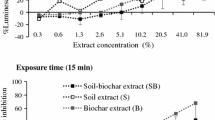Abstract
Research has demonstrated the usefulness of the Microtox™bioassay in assessing the acute toxicity of organic compounds. Recently, the use of the Microtox™bioassay has been extended to applications in hazardous waste management. The rapidity of the test, low sample requirements, and low cost provide several advantages over chemical analysis, especially for complex waste mixtures. Microtox™bioassay results correlate closely with results from rainbow trout bioassays, and are more sensitive to inhibitory chemicals than activated sludge organisms. An experimental approach using batch reactors and soil columns was implemented in the laboratory to evaluate the detoxification and mobility of a toxic complex hazardous waste in soil. The objective of the study reported here was to quantify the extent and rate of detoxification of a complex hazardous waste as affected by soil type and waste application rate. The extent and rate of detoxification was directly related to waste loading rate for both soil types investigated, in both batch reactors and soil column reactors. Analysis of the toxicity of aqueous soil extracts at incremental depths through soil columns and of soil columnn leachate indicated a low leaching potential for the complex petroleum refinery waste.
Similar content being viewed by others
References
Beckman Instruments, Inc. (1982) Beckman Microtox Systems Operating Manual, Microbial Operations, Carlsbad, CA 92008
Black, CA (1965) Methods of Soil Analysis, Part 1: Physical and Mineralogical Properties, Including Statistics of Measurement and Sampling. American Society of Agronomy, Madison, Wisconsin
Boerger H, Mackinnan M, Aledsiuk M (1984) Use of toxicity tests in studies of oil sands tailings water detoxification. Eleventh Annual Toxicity Workshop. Vancouver, British Columbia, Canada
Burks SL, Amalon M, Stebler EF, Harmon J, Leach F, Sanborn M, Matthews J (1982) Comparison of acute response of Microtox™,Daphnia magna, and fathead minnows to oil refinery wastewaters. Progress Report to Oil Refiners' Waste Control Council by Oklahoma State University Water Quality Research Laboratory, Stillwater, Oklahoma
Calleja A, Baldasana JM, and Mulet A (1986) Toxicity analysis of leachates from hazardous wastes via Microtox™ andDaphnia magna. Toxicity Assessment 1:73–83
Casseri NA, Ying W, Soiyka SA (1983) Use of a rapid bioassay for assessment of industrial wastewater treatment effectiveness. In: Bell JM (ed) Proceedings of the 38th Industrial Waste Conference, Purdue University. Ann Arbor Science, Boston, Massachusetts, pp 867–878
Indorato AM, Snyder LB, Usinowicz PJ (1984) Toxicity screening using Microtox™ analyzer, In: Lui DL, Dutka BJ (eds) Toxicity screening procedures using bacterial systems. Marcel Dekker, New York, pp 37–53
King EF (1984) A comparative study of methods assessing the toxicity to bacteria of single chemicals and mixtures. In: Lui DL, Dutka BJ (eds) Toxicity screening procedures using bacterial systems. Marcel Dekker, New York, pp 175–194
Mackinnon MD, Ratlock JT (1982) Preliminary characterization and detoxification of tailings pond water at the Syncrude Canada Ltd oil sands plant. In: Pearson JG (ed) American Society for Testing and Materials. Philadelphia, PA, pp 170–178
Matthews JE, Bulich AA (1984) A toxicity reduction test system to assist in predicting land treatability of hazardous organic wastes. Presented to the ASTM Committee on Solid Waste Treatment (ASTM Committee D-34). Washington, DC
McDowell AS, Boardman GD (1986) Three screening tests for the evaluation of ground water quality. (In press)
McTernan WF, Kocornik DJ, Pedram EO (1983) Physical-chemical approaches for the environmentally sound disposal of oil shale retort water. Liquid Fuels Technol 1:335–354
Page AL (1982) Methods of Soil Analysis, Part 2: Chemical and Microbiological Properties. Second Edition. American Society of Agronomy, Madison, Wisconsin
Peake E, Maclean A (1983) The toxicity of waters produced duringin-situ recovery of oil from the Athabasca oil sands as determined by the Microtox™ bacterial system. Ninth Annual Toxicity Workshop, Edmonton, Alberta, Canada Nov. 2–5, 1983
Qureshi AA, Flood KW, Thompson SR, Janhurst SM, Inniss CS, Rokosh DA (1982) Comparison of a luminescent bacterial test with other bioassays for determining toxicity of pure compounds and complex effluents, In: Pearson J G, Foster RB, Bishop ME (eds) Aquatic toxicology and hazard assessment: Fifth conference. ASTM STP 766. American Society for Testing and Materials, pp 179–195
Strosher MT (1984) A comparison of biological testing methods in association with chemical analysis to evaluate toxicity of waste drilling fluids in Alberta, Vol. I. Canadian Petroleum Association Report, Calgary, Alberta, Canada
US Environmental Protection Agency (1986a) Permit guidance manual on hazardous waste land treatment demonstrations. EPA-530/SW-86-032 Office of Solid Waste. U.S. Environmental Protection Agency, Washington, DC
— (1986b) Waste/soil treatability studies for four complex wastes. EPA/600/6-86/003a. Robert S. Kerr Environmental Research Laboratory. Office of Research and Development. U.S. Environmental Protection Agency, Ada, Oklahoma
Vasseur P, Ferod JF, Rost C, Larbaight G (1984) Luminescent marine bacteria in ecotoxicity screening tests of complex effluents, In: Lui DL, Dutka BJ (eds) Toxicity screening procedures using bacterial systems. Marcel Dekker, New York, pp 23–37
Author information
Authors and Affiliations
Rights and permissions
About this article
Cite this article
Symons, B.D., Sims, R.C. Assessing detoxification of a complex hazardous waste, using the Microtox™bioassay. Arch. Environ. Contam. Toxicol. 17, 497–505 (1988). https://doi.org/10.1007/BF01055515
Received:
Revised:
Issue Date:
DOI: https://doi.org/10.1007/BF01055515




